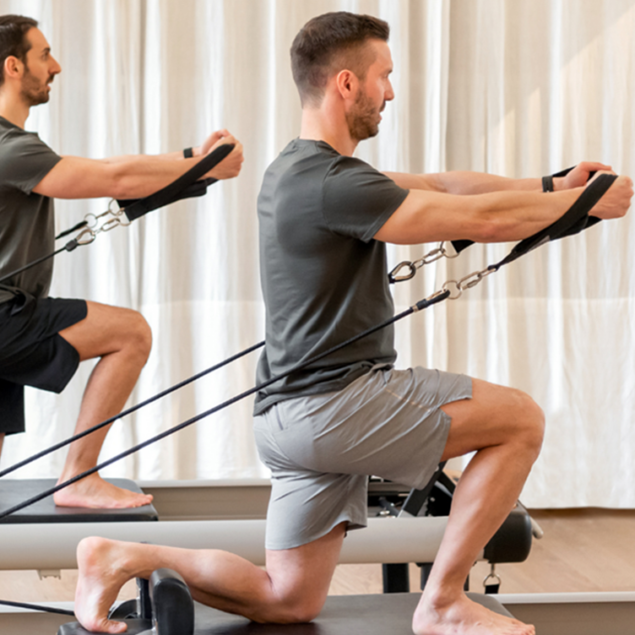
Pilates is one of the oldest and most popular forms of exercise. Developed in the 1920s as a method of rehabilitation, it draws inspiration from callisthenics, yoga and ballet.
Over the years, Pilates has evolved into a comprehensive fitness system. It’s known for its ability to enhance core strength, balance and mental well-being.
Practising Pilates for strength and flexibility can lead to benefits that extend across the entire body. In this guide, we’ll talk about how Pilates exercises work to improve overall health.
Pilates utilises around 50 simple, repetitive exercises to engage muscles effectively. These exercises are versatile and can be customised for gentle strength building during rehabilitation or intense workouts for athletic training.
There are various types of Pilates that suit different fitness objectives and lifestyles, this includes:
Among the various types, Reformer Pilates is one of the most popular options. It employs a specialised piece of equipment known as the reformer, which consists of a sliding carriage attached to springs of varying resistance levels alongside adjustable straps and bars. Through the use of the reformer, Reformer Pilates differentiates itself by enhancing traditional Pilates techniques and facilitating a full-body workout. The reformer’s design allows for a broad range of motion and accommodates all skill levels, from beginners to advanced practitioners.
Reformer Pilates targets specific muscle groups with heightened intensity and efficiency. Many of its exercises encompass dynamic stretching, boosting both flexibility and joint mobility. In other words, exercises performed on a reformer are more controlled, adding a level of precision to the movements, which helps isolate and engage deeper muscle layers.
Pilates involves ample stretching, which helps improve flexibility. When muscles are tight, they restrict the body’s ability to move freely and comfortably. Stiff muscles can exert tension on joints and ligaments, resulting in considerable discomfort.
Besides expanding the range of activities you can do, better flexibility offers these benefits:
Below are top Pilates exercises for flexibility that engage various areas such as the hips, hamstrings, back, front-body and side-body. Be sure to properly warm up before trying any of these movements.
The Mermaid exercise in Pilates is a seated stretch that targets the sides of the body, spine and shoulders. It involves sitting on the reformer with legs folded towards the shoulder pads, resembling the position of a mermaid’s tail and the closest hand on the footbar. The practitioner then presses away from the footbar, sliding the carriage down the rails and reaching the other arm overhead to create a lateral stretch along the torso. This exercise helps improve spinal flexibility, mobility and posture while promoting relaxation.
The Power Swan exercise involves improving spinal extension and expanding the chest.
To perform the Power Swan, position the box long ways on the carriage and lie face down on the box while supporting your hands on the middle power bars. Keep your pelvis anchored to the box as you press your hands down on the power bars, lift your chest and drag the carriage up the rails. Experience a gentle stretch in your abdomen as you lengthen your spine.
The Long Spine Sequence involves improving spinal flexibility, balance and body awareness.
To perform the Long Spine Sequence, lay your back on the carriage with the long straps around your feet. With straight legs, lift your legs upwards and continue to lift your back and body up into an almost vertical position with the toes pointing towards the ceiling. Then, split the legs into a V position and slowly and mindfully roll your spine and body back down onto the carriage. Once your hips are back in contact with the carriage, join your legs in a circle.
Pilates engages your core muscles in every exercise. Unlike traditional strength workouts, Pilates strength training prioritises improving muscle tone over bulk.
Your core encompasses more than just the vertical muscles along the abdomen and sides of the body. It also includes vital stabilising muscles such as the transverse abdominus, hips, lower back and pelvic floor. Strengthening these muscles is crucial for maintaining balance and stability in the body.
Here are popular Pilates strength exercises that target core muscles and improve overall body control:
Pilates one hundred is a classic exercise. Begin by lying face-up and lifting both legs towards the ceiling. Then, lower them halfway to form an angle. Curl your head up, extending your arms long beside your body with palms facing down. Alternate pumping your arms upwards and downwards while inhaling for five counts, then exhaling for five counts. When doing this on a reformer, you have to hold the straps in your hands for an extra strength challenge.
This movement targets hip flexibility while challenging stability. Begin by lying on your back and bringing both knees into table top position. Place your hands in the straps, pull them down by your side and curl your head off the headrest.
Alternate extending one leg out at a time. Be sure to keep your core engaged and lower back pressed into the carriage. For an extra challenge, you can lift and pull on the arm straps in time with the legs.
When it comes to a Pilates body vs. a gym body, the former tends to be lean, toned and elongated, while the latter often features larger muscles and a more sculpted appearance.
If you enjoy low-impact workouts with a focus on improving strength, posture and mind-body connection, Pilates may be the ideal choice for you. But if your primary goal is to build muscle mass, heavy lifting and high-intensity cardio training might be more appealing.
Achieve your wellness goals at KX Pilates! Whether you’re new to Pilates or seeking more demanding exercises, we offer beginner, intermediate and advanced classes that align with your fitness journey.
With over 100 studios conveniently located across Australia, engaging in Pilates has never been easier. Book a class and discover the incredible benefits of Pilates exercises for flexibility and core strength.